Function in Math
In mathematics, functions are relations where each input has a particular output. Functions are widely used in the field of science and mathematics. In this section, we will learn the concepts of functions definition, types of functions, properties along with examples for better understanding.
A function represents the relation between two different sets. Every element of the first set must be associated with an element of the second set.
Consider the following figure, each input element is associated with a single output element. So, the relationship represents a function.
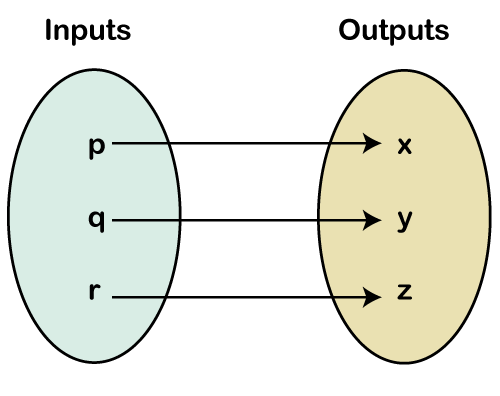
Let’s take another example. The following figure does not represent a function because the input element q is associated with two different elements of the output.
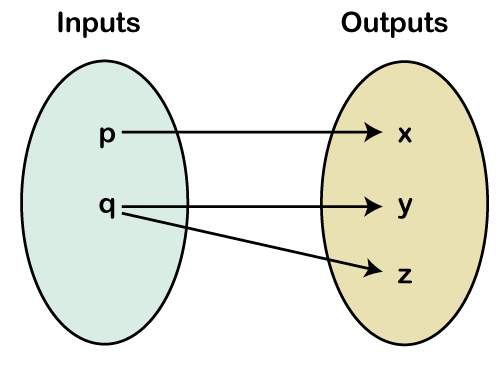
Function Definition
A function is a mathematical process that uniquely relates the value of one variable to the value of one (or more) other variables.
Terms Related to Function
- Domain: In a function, it is a set of all possible inputs. In other words, it is a set of possible input variables.
- Codomain: The possible output of a function is called codomain. In other words, it is an image of a function.
- Range: The actual output of a function is called range.
Suppose, there are two sets named X and Y having elements {a, b, c, d} and {w, x, y, z}, respectively. Every element of the set X is associated with an element of the set Y. The set X is called the domain and the set Y is called the codomain of the function. The range is the actual output of the function f, i.e. {v, w, z}.
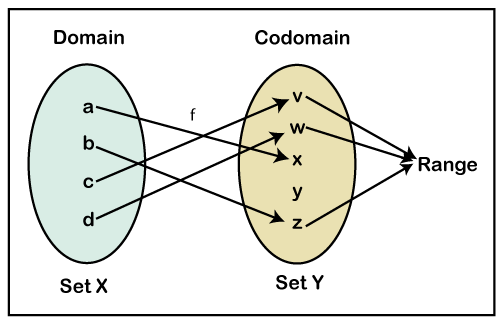
Function Notation
Function notation is a way to represent a function or define a function. It defines the name of the function with an equation. There are following four methods to denote a function.
- Functional Notation
- Arrow Notation
- Index Notation
- Dot Notation
Functional Notation
The functional notation first used by the mathematician Leonhard Euler. The most commonly used letters are f, g, and h. The letter must be italic and in lower-case. It is the most commonly used notation.
Mostly, we represent a function with the letter f which is called the function name. The relation is denoted by the y=f(x)(read as f of x). The element xis known as input or argument of the function and y is known as output (the value of the function) or the image of x by y.
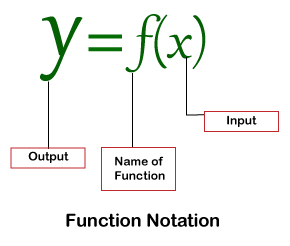
It means that the pair (x,y) belongs to the set of pairs that defines the function f. If X is the domain of f, the set of pairs defining the function using set-builder notation is:
For example, a function f can be defined by the equation:
Arrow Notation
The arrow notation is used when we want to represent domain explicitly. Suppose X is a domain and Y is codomain of a function f, then the notation of the function will be:
Read as: the function f from X to Y.
The above function can also be written as:

Read as: the function f maps the elements of X to the elements of Y.
For example, if a multiplication is defined on a set X then the square function sqr on X is defined by:
Read as the function sqr from X to X that maps x to x.x.
Index Notation
Index notation is used in place of functional notation. It means use fx in place of f(x). It is used for a function whose domain contains a set of natural numbers. A function that contains a set of natural numbers is called sequence.
For example, in index notation x→f(x,t) can be denoted as ft. If we define the collection of maps ft by the formula:
Dot Notation
In functional notation, the symbol x does not represent any value. It is a just a placeholder. If we replace x by any value on the left of the arrow, it must be replaced by the same value on the right of the arrow. To change the value of we use an interpunct (·) that distinguish the function f(·) from its value f(x) at x.
For example, we can represent a(·)2 in dot notation as x→ax2.
Types of Functions
The functions can be classified on the basis of variable used. There are following types of functions:
- One-One Function (Injective Function)
- Many-One Function
- Onto Function (Surjective Function)
- Into Function
- Algebraic Function
- Exponential Function
- Logarithmic Function
- Analytic Function
- Inverse of Function
- Monotonic Function
- Polynomial Function
- Linear Function
- Quadratic Function
- Relation Function
- Cubic Function
- Modulus Function
- Constant Function
- Composite Function
- Periodic Function
In this section, we will discuss some commonly used function only.
One-One Function
In one-one function, each element of a domain has a distinct image in the codomain. It is also called injective function. If x1 and x2 are two different inputs of a function f, then f is one-one function if f( x1 )≠f( x2 ).
In the following image, each element of the set X has a distincit image in codomain Y and no two elements has the same image.
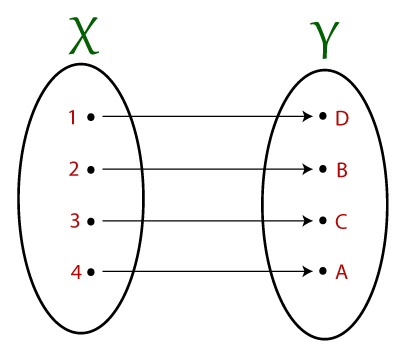
Many-One Function
In many-one function, two or more elements of a domain have the same image in the codomain.
In the following image, a set X has elements {1, 2, 3, 4} and the set Y has the elements {a, b, c, d, e, f}. The elements 1 and 2 have the same image in the set Y i.e. is b.
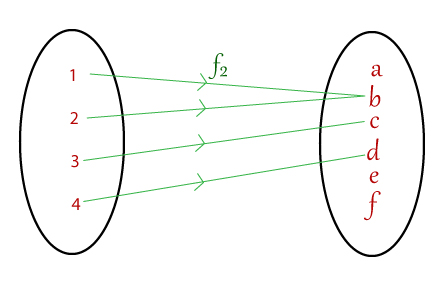
Onto Function
A function f is called an onto function or surjective function if each element of set Y has at least one-pre image in the domain.
In the following image, we can see that each element of set Y has a pre-image or matching element in the set X.
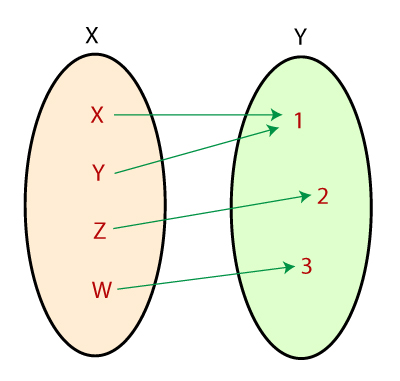
Into Function
A function f is said to be into function if there exist at least one element in codomain which is not the image of any element in domain.
In the following image, there is an element (4) in codomain that has no image of any element in domain.
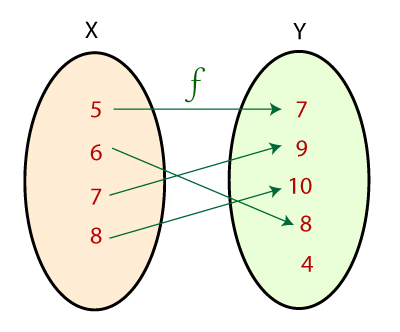
Identical Function
Identical function is also known as equal function. The two functions f(x) and g(x) are said to be identical if and only if they satisfy the following two condition:
- Domain of f(x) = Domain of g(x)=x
- Range of f(x) = Range of g(x) or f(x)=g(x) ∀ x ϵ X

The graph of identical function always passes through the origin. The following graph represents the identical function graph for f(x)=x.
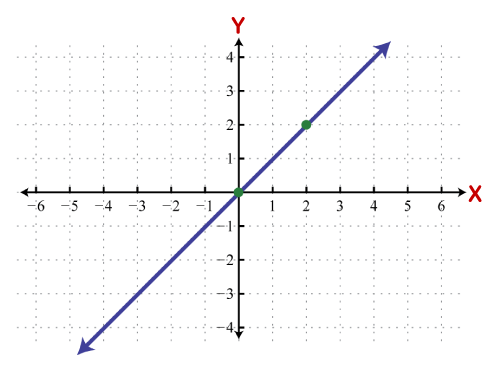
Inverse Function
When all the elements of the domain become the range, and vice-versa is called inverse function. It is denoted by f-1 (read f-inverse). Consider the following function f with a set of ordered pair, where x is domain and y is range.
f(x)={(x,y):(3,6),(1,12),(7,2),(9,4)}
The inverse of the function will be:
f-1 (x)={(x,y):(6,3),(12,1),(2,7),(4,9)}
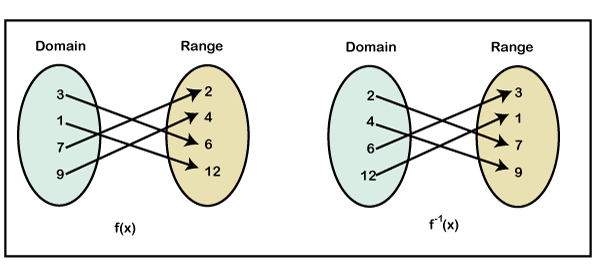
There are four steps to find the inverse of a function:
- Replace the function f(x) with y
- Swap the x and y variables
- Solve for y
- Replace y with f-1(x)
Example: Find the inverse of the function f(x)=x-4.
Solution:
Step 1: y=x-4
Step 2: x=y-4
Step 3: y=x+4
Step 4: f-1 (x)=x+4
Let’s plot a graph for the function f(x)=2x and its inverse f-1(x)=y. For the function, we have taken different values of x which are 0, 2, 4.
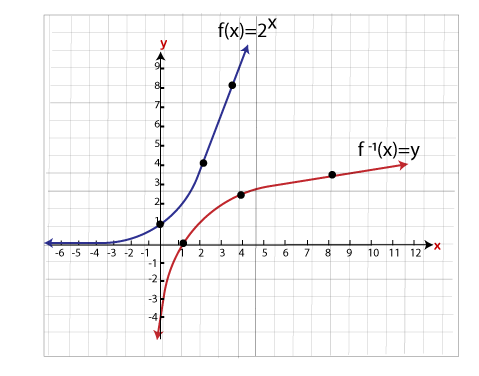
Cubic Function
A function that has a polynomial of degree three is called cubic function. For example, f(x)=ax3+bx2+cx+d, where a, b, c, d ϵ R and a≠0.
Let’s plot a graph for the function f(x)=ax3 where a is constant. We have taken the value of a that is 1 and the values of x are -2, -1, 0, 1, 2. After putting these values in the function, respectively we get the points and then we plot the graph.
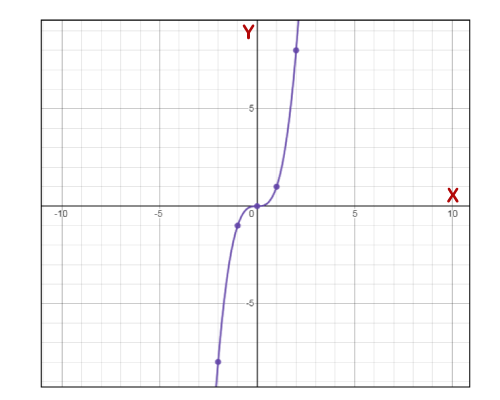
Quadratic Function
The general form of quadratic function is f(x)=ax2+bx+c, where a, b, c are real numbers and a≠0. The graph of a quadratic function always in U-shaped.
Let’s plot a graph for the function f(x)=ax2 where a is constant. We have taken the value of a that is 1 and the values of x are -2, -1, 0, 1, 2. After putting these values in the function, respectively, we get the points and then we plot the graph.
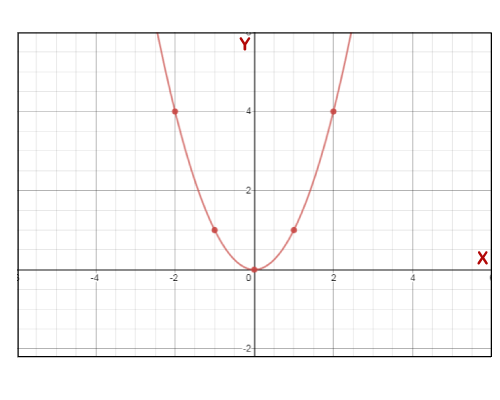
Constant Function
In the constant function, the value of output is same for every input. The general form of a constant function is f(x)=c or f=c. When we plot the graph of the constant function, we get a horizontal line in the plane that passes through the point (0,c).
Let’s plot a graph of the function f(x)=c. In the following graph, we can see that for the different values of x, we get the same output.
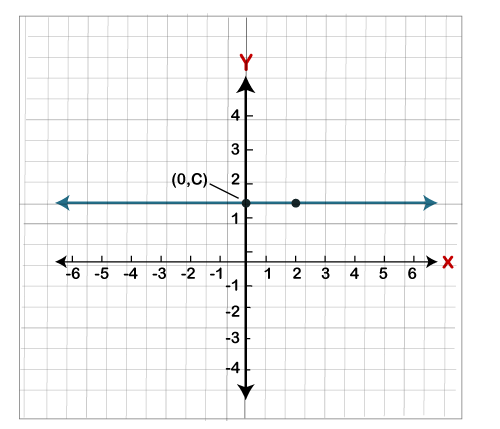
Modulus Function
It is a function that gives the absolute value for a variable. The property of the modulus function is that its outcome is always positive. It does not matter what the input is given to the function. The modulus function f(x) of x can be defined as:
Consider the above:
- The output of the function f(x) will be x if x is a positive number.
- The output of the function f(x) will be the magnitude of x if x is negative.
In short, the above two points can be written as:

The graph of the modulus function is similar to V-shape. Let’s plot a graph of the function f(x)=|x|. For the function we have taken different values of x which are given in the table.
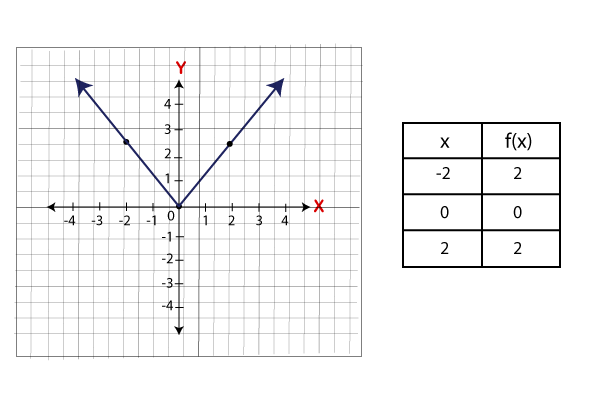
Example:
For x=-9, the value of y will be: y=f(x)=-(-9)=9
For x=2, the value of y will be: y=f(x)=2
For x=0, the value of y will be: y=f(x)=0
Function Properties
- f(x)=x is the identity function.
- f-1 (f(x))=f(f-1 (x))=x
- Generally, f(g(x))≠g(f(x)) the order of composition is important.
